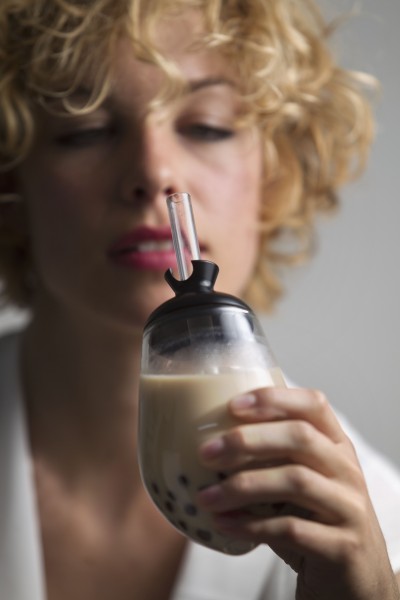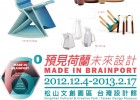BaBo 珍珠奶茶玻璃杯
珍珠奶茶玻璃杯
english text below
身為一個歐洲人訪台的經驗中,台灣存在一些顯著的差異性。對於PeLi來說:台灣的社會是新鮮而富有創造性的。
台灣似乎是年輕而且不太害怕改變;實驗性彷彿存在於台灣的DNA裡。 不知這是根深於一個海島國家有限資源的事實亦或是那特有的殖民歷史(曾被葡萄牙、荷蘭和日本所佔領)積累而成了這種特殊的“台灣方式“…..也許,是在所有境況下的組合體。
然而,在台灣可以回顧到幾千年的中國文化遺產 (豐富點綴的道教與佛教寺廟及茶道)。這種古老與現代明顯共存於台灣,如此豐富的多樣性是讓PeLi在歐洲的家鄉中遍尋不著的。
當他拜訪台南時,他驚訝的發現到這個城市是如何的汰舊換新,他當下正視到這種創造“建構未來方式“的視野與機會。
改變不僅止於台灣的建築,自然的創新也相當程度反應在台灣的日常生活物件裡。他盡收眼底並且也將其紀錄下來,台灣人可謂是“與生俱來的設計師“。
當PeLi被問及設計一件作品能夠意味著台灣或是台南市,他想要表現出的就是這種充滿人情味的印象。
因此,他創造了珍珠奶茶玻璃杯。
在1986年台南的一家茶店發明了珍珠奶茶(部份的議論為早先於1983年在台中發跡,不論如何….珍珠奶茶是純正的台灣血統),而其湧現出的是台灣的創新性及結合中國的茶文化。
對PeLi來說,珍珠奶茶結合了古老與新奇的方式,藉此創造出一種新的文化涵養。
通常珍珠奶茶都是以塑膠杯的方式供應。
PeLi將其改造為比例勻稱而且更具價值的玻璃材質並加上了以杯蓋與支架。PE塑膠材質的杯蓋可將玻璃吸管固定,當你享用時只需由杯蓋上的開口將吸管插入。
設計師擷取存放中藥的陶瓷罐為靈感來設計珍珠奶茶玻璃杯的型體。不同於存放草藥的罐子,玻璃杯的的底部為圓弧狀,藉此所有的珍珠可以聚集在杯底的最低處 – 你可以不須移動吸管而喝到所有的珍珠粉圓。
使用玻璃材料代替用盡即棄的材質,製作珍珠奶茶杯的概念將飲茶文化推向至更高的層面,帶入古老與真實的茶道境界。
In spring 2012 PeLi has been asked by Mr. Hu Yu-Zong , of NDD (one of the most influential Taiwanese design companies) to design a product inspired by Taiwan and especially by the city of Tainan…
BaBo, bubble tea glass
For PeLi the Taiwanese society is fresh and inventive. As a European who is coming to visit Taiwan there are some remarkable differences.
Taiwan seems younger and less afraid of change. It seems that experimentation is in the DNA of Taiwan. The designer doesn’t know if this has its roots in the fact that Taiwan is an island with limited resources or that the special “Taiwan way” is rooted in the particular history (occupation by Portugal, Holland and Japan)…maybe it’s a combination of all of these circumstances.
Nonetheless, Taiwan can look back on thousands of years of Chinese cultural heritage (think of the richly adorned Taoist and Buddhist temples or the tea ceremony). The coexisting of old and new is also very apparent in Taiwan, this leads to a richness that is not found in this way in the European home of PeLi…
When he visited Tainan he found it stunning how easily old parts of the city are broken down to make way for new buildings. PeLi was positively surprised by the views and opportunities this “way of constructing the future” creates.
But not only in the macro scale of architecture the Taiwanese not afraid of change, also in everyday objects the Taiwanese people embrace new opportunities…for him a natural inventiveness is apparent in Taiwan – He has seen and documented this in a lot of examples. One could say that Taiwanese people are “natural born designers”.
When PeLi was asked to design an object that signifies Taiwan or in particular the city of Tainan, he wanted to show the impression this very hospitable country (and that city) made on him.
So he created a bubble tea glass.
In 1986 bubble tea was invented by a Tainan tea shop (some nonbelievers dispute that and say it was already conceived in 1983 in Taichung…but however that may be, bubble Tea is purely Taiwanese).
But hey, it’s coming forth of the Chinese tea culture combined with Taiwanese inventiveness.
Bubble tea for PeLi incorporates the very old but does that in a fresh and playful way…in this manner a new culture is created.
Normally the bubble tea is served in plastic cups.
PeLi transformed this into a more valuable and well proportioned glass with a lid and a stand.
In the lid, made of polyethylene, the glass straw can be fixed. When you want to drink you pull out the straw and insert it through an opening in the lid.
The designer got his inspiration for the shape of the bubble tea glass from the ceramic vessels used for the ingredients of Chinese medicine. But different from the jars for herbs, the bottom of the bubble tea glass is not flat, but rounded – in this way you can drink all the tapioca pearls without moving the straw (the pearls sink to the lowest point of the glass)
The whole concept of making a bubble tea cup not from throw-away materials but from real glass, places the whole concept of bubble tea drinking on a higher level…more close to the real and ancient tea ceremony.
photos by Kees Martens, model Lisa Grahner, thanks!





